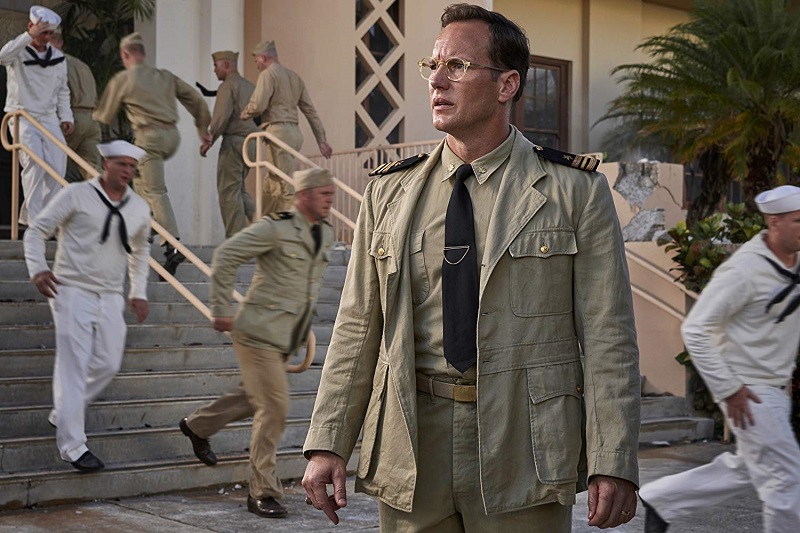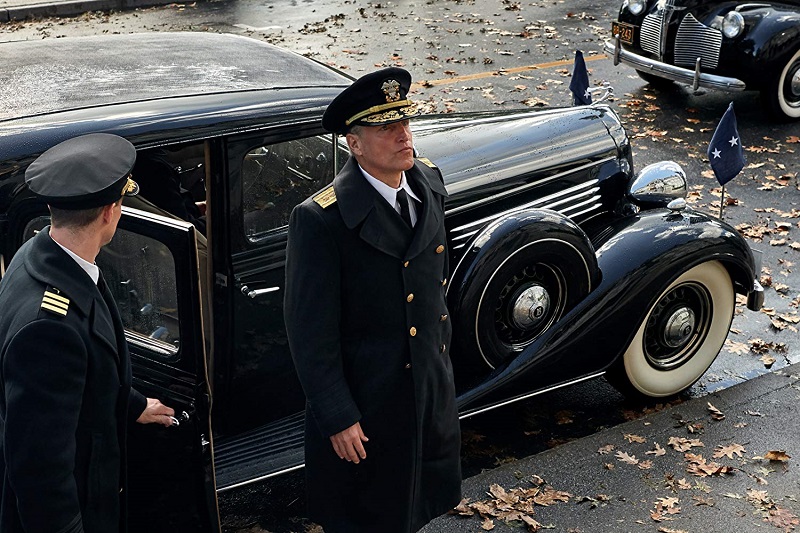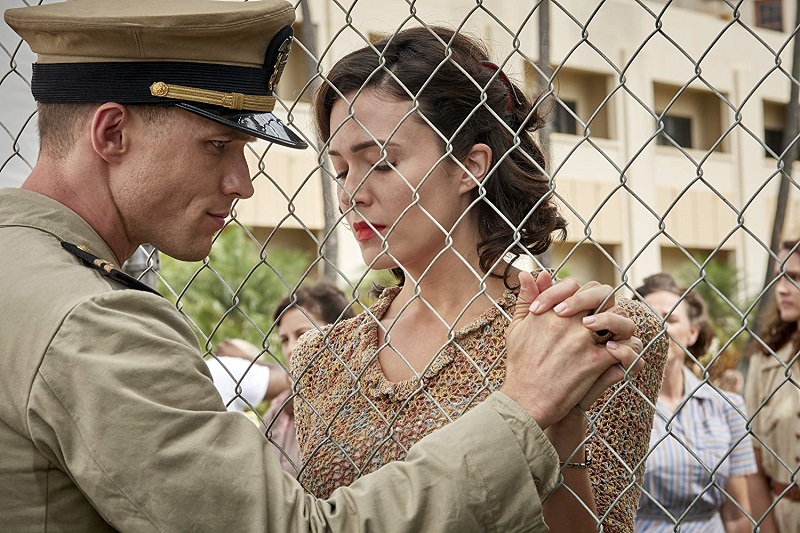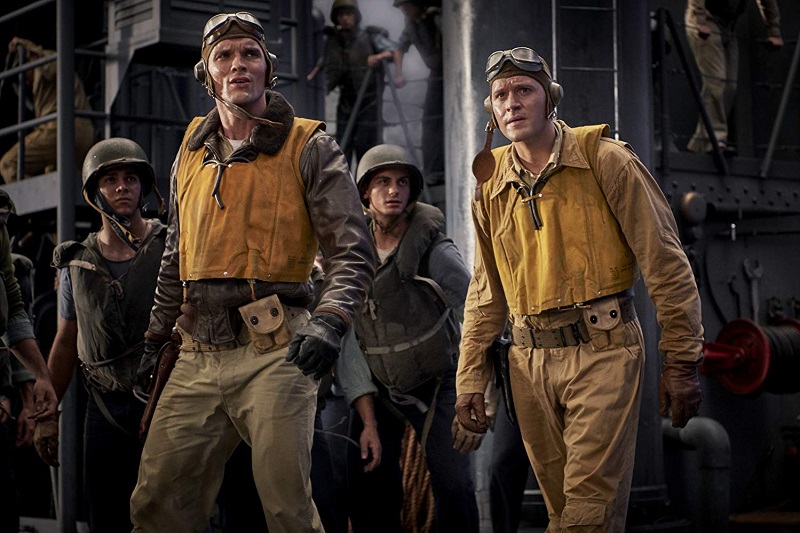Roland Emmerich is not necessarily known as a sage storyteller. His latest, Midway, recounts the historic America response to the attack on Pearl Harbor. That much is clearly presented and once we get into the thick of the battle, the lack of character development comes back to haunt him like a torpedo creeping under the surface.

Emmerich is the screenwriter and director who is responsible for giving us Independence Day, The Day After Tomorrow, Godzilla and White House Down. Now, he did deliver the impressively creative Anonymous about Shakespeare not being who history has deemed him to be—but that’s another subject for another time. For the most part, audiences are OK with the method to his action driven madness that is presenting one (or two at the most) dimensional characters that serve one purpose. They are to carry us to, through and past numerous CGI-driven action sequences and to never scratch the surface too closely. Sadly, only one part of his two-sided filmmaking coin works with a subject matter such as that which is portrayed in Midway.
The film is told from the point of view of those charged with responding to the December 7, 1941 attack by the Japanese—from the military leadership, the brave and selfless pilots, right on down to those grunts who keep the war machine ticking.
In a surprise stroke of story foreshadowing, there is a preamble featuring intelligence officer Edwin Layton (Patrick Wilson), who is in Japan. It’s 1937 and he steals a moment from a Japanese naval leader, Isoroku Yamamoto (Etsushi Toyokawa), at a social gathering for the two countries. The officer basically informs Layton that he is fighting the good fight behind the scenes, but that his higher-ups firmly have expansionist designs—i.e. he believes a Japanese attack in the Pacific is eminent and will be massive.
The film fast forwards to that “day that will live in infamy” and the Empire of Japan is attacking Pearl Harbor, something America does not seem at all ready to respond to, immediately and even soon after. That attack is portrayed as about as horrifying as it ever has been onscreen. Yes, even more intensely than Michael Bay achieved in his 2001 utter mess, Pearl Harbor. Emmerich also doesn’t linger on it—he showcases just enough for us to be emotively moved at the horror, massive loss of life and a perceived innocence that was completely shattered by sundown as our biggest Pacific naval base smoldered. Then, it is adequately presented that the United States must respond as quickly as possible and “deliver a massive punch” to show both the Japanese military that they just awoke a sleeping giant and the American people and its armed forces to skyrocket that sinking collective morale.
Then, the script by Wes Tooke (making his big screen debut, and it feels it in not a good way) shifts into stereotypical World War II movie mode where all the tropes are front and center and telegraphed from miles away. Can’t believe I’m saying this, but it makes one wonder how the story would have been laid out if Emmerich penned the script (which he usually does). What else hinders the ability of the viewer to tether themselves to the justice-driven response is a whole series of those aforementioned one or two-dimensional characters whose sacrifice—history tells us—is immense and extraordinary—but in Tooke’s story, it hardly registers beyond the obvious.
Wilson is given the most flushed out soul on the cast list. Therefore, it is hardly a surprise that he delivers the richest performance. From that opening scene through his “I’ll sleep and make it up to my wife for all the time away when the war’s over” attitude, Layton is about as much of a main character as exists in Midway. So, kudos to Tooke for at least giving us one soul to connect to. It’s just too bad that he is never the one who gets caught in crossfire, drowns at the hands of the Japanese because he won’t give up information on his fellow sailors or must bail out of his plane over Japanese controlled China after dropping bombs on Tokyo. Each one of those folks (and more) are hallowed heroes in the film, tragically. See, many of these characters are based on real people. This is presented as the definitive story of what happened leading up to and during the battle of Midway.

For example, Woody Harrelson portrays an utter legend, Chester W. Nimitz. The admiral was central to our Pacific strategy, starting with authoring the attack at Midway. Harrelson, first of all, is probably a tad too young to portray the Navy icon. He’s given some gray hair and does the best he can (which is immense) with the material he is given. Yet in the context of the overall arc of the story, there isn’t much to report about Nimitz from Midway that I didn’t know from history. Heck, if I didn’t have that history, then understanding his contribution to our war victory would fail to exist. It’s just flat. Same thing with William ‘Bull’ Halsey and the supreme talent that portrays him—Dennis Quaid. The veteran actor comes off like he did countless hours of research as his embodiment of Halsey is gripping, but only on the surface. There is little provided by exposition or actual dialogue to discern anything about him beyond him coming off as the prototype of a gravely-voiced Greatest Generation member whose willingness to selflessly do what it takes to win is his modus operandi. And don’t get me started on the disastrous excuse of a character that Darren Criss plays!
Then, there’s Dick Best (Ed Skrein). The pilot is given his Top Gun moment early in the story. You know the one, where he does something that comes off as careless, reckless and perceived by the brass as showing off. Those of us who have seen a war movie or two can tell a million miles away that the little stunt is not only a slice of cheap, low hanging character development fruit, but during the titular battle, will become all-important. Again, the actor does as much as he can with a part that is not flushed out beyond stereotypes.
Skrein is commanding in the role, much more than anyone else actually doing the fighting. But he also suffers from another stereotype in the personal story aspect of his characterization. He has the long suffering wife at home, Ann Best (Mandy Moore), and a little girl—who we never actually see him interact with, other than sitting on her bed and staring at her while she sleeps. Early on, Moore is given a scene where she confronts her hubby’s bosses for not utilizing him to his fullest in a moment that is meant to illustrate how this couple is a team and how she believes in his talents profusely. The whole thing with Best just comes off as something we’ve seen prior in a dozen other war movies and done so in a way that has more emotional power previously.

What Best does during the Battle of Midway is the stuff of legend, but we never feel the weight of that accomplishment since there was never anything Tooke wrote for his character that could lead to any kind of raw emotive truth.
Heck, even Aaron Eckhart is in this thing. Jimmy Doolittle’s contribution to the fight against the Japanese, also epic, but as seen in Midway, just kind of happens, matter-of-factly, and worse, we never hear from him again until the close of the movie these are the people in real life retrospective where we finally learn his fate and why his sacrifice was so stunning.
Emmerich has painted a fascinating picture here that is puzzling. He utilizes countless beats that are right out of dozens of other war movies whose legacy is as flat as Tooke’s character building. Yet it is all orchestrated with battle sequences that could not look more modern as the technology utilized is blindingly bombastic in the best of ways. Rarely has the air fight of World War II, particularly over the Pacific, been so magnificently captured on film. We’ve got 60-year-old tropes framed by 21st century effects wizardry. It’s the oddest of contrasts. There’s even a moment where a few military officers are looking out over the battle. Somehow, Emmerich has crafted a moment that literally feels like three actors who are looking at a green screen. Meanwhile, that green screen is showcasing some mind-blowing effects.

For those of us who are fascinated by that era, there are some truly astonishing representations in cinema whose artistry should be celebrated. Sometimes the scope can feel small in those rich, wide-spanning, tales. Those are the best opportunities to fully appreciate the Greatest Generation and how their selfless sacrifice brought down tyranny that was taking over the world from a myriad of locales. For example, The Bridge Over the River Kwai or Sands of Iwo Jima tackle something that is vast in scope but does so in the most powerful of ways because the filmmakers gave audiences fully developed characters whose loss is felt deep in our soul. One can still have a scale as vast as what Emmerich employs in Midway and still deliver thrills and tears. His use of throwing dozens of players at us and hoping that one will pull our heartstrings has rarely worked before with his films. Why did he think it would be effective with this story that required an emotive intimacy that simultaneously served up visual spectacle?
Grade: C-

